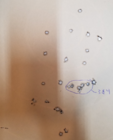Greetings fellow load developers,
Wanted to share our load development method in the hope that it will save people a lot of time and barrel life. Using this method, we are usually finished with load development before the barrel has a hundred rounds on it. It is very similar/the same as Erik Cortina's method, just done in the form of a ladder at 500-1000 yards instead of 100. What we look for is identical...just easier to see at distance.
Today, we had a brand new 284 Shehane barrel and participated in a 500 yard match.
1. First string, we used our regular match load for other barrels and shot a 199-10X while fouling the barrel.
2. With the barrel fouled, we performed a ladder test as shown below. Loads 3 & 4 tightened up nicely and were right on top of each other. Our chosen load is 54.9 to 55.0 grains.
3. Once we know the load, chrono a few rounds and record the velocity. I believe load development is simply tuning barrel harmonics and velocity is what produces specific harmonics. In other words, note the velocity that shoots the best and then maintain that same velocity throughout the life of the barrel. Regardless of what is going on with barrel break-in, wear & tear. component lot changes,etc....just maintain the velocity and your rifle will usually keep shooting just as well. Regarding seating depth, we seat all our hybrids .015 off the lands when the barrel is new and never change it again. Simply maintain the velocity by changing the powder charge as the barrel wears.
4. No more steps, our load development is complete in 50 rounds. Christine will be using this one at the Bergers this year.....if she gets in.
Christine will be using this one at the Bergers this year.....if she gets in.
I wanted to post this info as a way to say you don't have to go crazy on load development. We compete in F-class and have produced good results with this method over the years. I think the more time you spend competing in matches, the better you will get. Minimizing load development gives you time to focus on the more important tasks of learning to compete and read the wind!
As a side note, we have 4 Shehane rifles outfitted with identical barrels and using the same chamber reamer. They all shoot the same brass and have tuned at exactly the same place. Same experience with my 308 WIN barrels: same brass, seating depth, and load. This is the way it works with good barrels from the same maker with the same specs. In short, I don't believe in the "each barrel is a snowflake" theory: quite the opposite. When they are made to the same spec, they tend to shoot the exact same loads. Barrels that don't shoot your known good load are usually the ones that don't shoot well.


Wanted to share our load development method in the hope that it will save people a lot of time and barrel life. Using this method, we are usually finished with load development before the barrel has a hundred rounds on it. It is very similar/the same as Erik Cortina's method, just done in the form of a ladder at 500-1000 yards instead of 100. What we look for is identical...just easier to see at distance.
Today, we had a brand new 284 Shehane barrel and participated in a 500 yard match.
1. First string, we used our regular match load for other barrels and shot a 199-10X while fouling the barrel.
2. With the barrel fouled, we performed a ladder test as shown below. Loads 3 & 4 tightened up nicely and were right on top of each other. Our chosen load is 54.9 to 55.0 grains.
3. Once we know the load, chrono a few rounds and record the velocity. I believe load development is simply tuning barrel harmonics and velocity is what produces specific harmonics. In other words, note the velocity that shoots the best and then maintain that same velocity throughout the life of the barrel. Regardless of what is going on with barrel break-in, wear & tear. component lot changes,etc....just maintain the velocity and your rifle will usually keep shooting just as well. Regarding seating depth, we seat all our hybrids .015 off the lands when the barrel is new and never change it again. Simply maintain the velocity by changing the powder charge as the barrel wears.
4. No more steps, our load development is complete in 50 rounds.
I wanted to post this info as a way to say you don't have to go crazy on load development. We compete in F-class and have produced good results with this method over the years. I think the more time you spend competing in matches, the better you will get. Minimizing load development gives you time to focus on the more important tasks of learning to compete and read the wind!
As a side note, we have 4 Shehane rifles outfitted with identical barrels and using the same chamber reamer. They all shoot the same brass and have tuned at exactly the same place. Same experience with my 308 WIN barrels: same brass, seating depth, and load. This is the way it works with good barrels from the same maker with the same specs. In short, I don't believe in the "each barrel is a snowflake" theory: quite the opposite. When they are made to the same spec, they tend to shoot the exact same loads. Barrels that don't shoot your known good load are usually the ones that don't shoot well.


Last edited:











